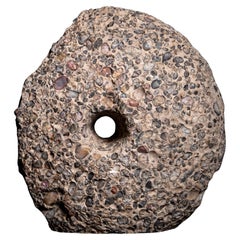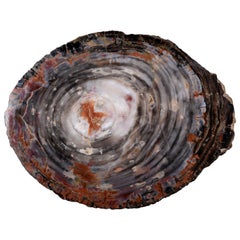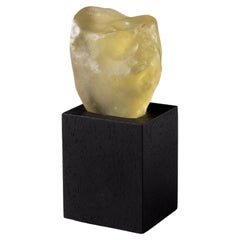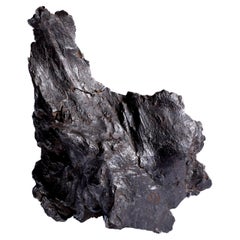Want more images or videos?
Request additional images or videos from the seller
1 of 9
Paleolithic Flint Handaxe from Prehistoric Northern France
$16,363.81List Price
About the Item
- Dimensions:Height: 5.4 in (13.7 cm)Diameter: 3.15 in (8 cm)
- Materials and Techniques:
- Period:
- Date of Manufacture:Circa .700,000 - 300,000 BC
- Condition:Wear consistent with age and use.
- Seller Location:London, GB
- Reference Number:1stDibs: LU1052244850892
About the Seller
5.0
Recognized Seller
These prestigious sellers are industry leaders and represent the highest echelon for item quality and design.
Platinum Seller
Premium sellers with a 4.7+ rating and 24-hour response times
Established in 2007
1stDibs seller since 2014
106 sales on 1stDibs
Typical response time: 7 hours
Associations
LAPADA - The Association of Arts & Antiques DealersInternational Confederation of Art and Antique Dealers' AssociationsThe British Antique Dealers' Association
Authenticity Guarantee
In the unlikely event there’s an issue with an item’s authenticity, contact us within 1 year for a full refund. DetailsMoney-Back Guarantee
If your item is not as described, is damaged in transit, or does not arrive, contact us within 7 days for a full refund. Details24-Hour Cancellation
You have a 24-hour grace period in which to reconsider your purchase, with no questions asked.Vetted Professional Sellers
Our world-class sellers must adhere to strict standards for service and quality, maintaining the integrity of our listings.Price-Match Guarantee
If you find that a seller listed the same item for a lower price elsewhere, we’ll match it.Trusted Global Delivery
Our best-in-class carrier network provides specialized shipping options worldwide, including custom delivery.You May Also Like
Large Prehistoric Ammonite
Located in New York City, NY
Prehistoric ammonite fossil.
Category
Antique 18th Century and Earlier Unknown Animal Sculptures
Materials
Stone
Prehistoric Fossil Fish Specimen
Located in Wormelow, Herefordshire
This rare fossil of a prehistoric fish is an impressive specimen originating from Brazil, preserved by time over millions of years. Mounted on a metal...
Category
Antique 15th Century and Earlier Brazilian Natural Specimens
Materials
Stone, Metal
Set of Three Prehistoric Ammonite
Located in Miami, FL
Set of three prehistoric ammonite fossil, unmounted.
Measurements:
Big amonite: Depth *4.5in Width *5.5in Height *1.6in
Medium amonite: Depth *4.1in Width *5.1in Height *1.6in...
Category
Antique 15th Century and Earlier Prehistoric Natural Specimens
Tibetan Flint Striker, C. 1850
Located in Chicago, IL
In 19th-century Tibet, many men carried a fire striker to help ensure survival in the often-harsh climate of the Tibetan Plateau. Known as mechag, such strikers would hang from one's belt and often doubled as a small pouch for flint and tinder. The finest strikers were finished with precious metals and decorated with repoussé and inlaid stones.
This leather flint pouch is decorated with silver and gold plated metalwork and three large beads of turquoise and red coral. The mechag hangs from a simple leather strap and three decorative leather beads hang below. The pouch contains two Tibetan prayer flags...
Category
Antique Mid-19th Century Tibetan Tibetan Mounted Objects
Materials
Coral, Gold Plate, Steel, Metal
Set of Three Kokeshi Dolls from Northern Japan
Located in Antwerp, BE
Kokeshi (こけし こけし, kokeshi), are Japanese dolls, originally from northern Japan. They are handmade from wood, have a simple trunk and an enlarged head with a few thin, painted lines t...
Category
Mid-20th Century Japanese Mid-Century Modern Figurative Sculptures
Materials
Wood
Huge Prehistoric Fossilised Whale Bone
Located in Wormelow, Herefordshire
Standing at over 120cm (47 inches) tall, this rare prehistoric fossilised whale bone is a fascinating sculptural artefact for an interior or live-in museum....
Category
Antique 15th Century and Earlier English Mounted Objects
Materials
Metal
Prehistoric Brannerion Fossil Fish Specimen
Located in Wormelow, Herefordshire
This rare Brannerion fossil specimen of a prehistoric fish is an impressive find from an ex private British collection.
Believed to be from Brazil, t...
Category
Antique 15th Century and Earlier Brazilian Natural Specimens
Materials
Natural Fiber
Tibetan Mechag Flint Striker, c. 1850
Located in Chicago, IL
In 19th-century Tibet, many men carried a fire striker to help ensure survival in the often-harsh climate of the Tibetan Plateau. Known as mechag, such st...
Category
Antique Mid-19th Century Tibetan Tibetan Mounted Objects
Materials
Metal, Steel
Flint Sculpture by Pol Quadens
Located in Geneve, CH
Flint Sculpture by Pol Quadens
Unique Piece.
Dimensions: D 100 x W 140 x H 600 cm.
Materials: Polished stainless steel.
Pol Quadens was born in Brussels....
Category
2010s Belgian Post-Modern Abstract Sculptures
Materials
Stainless Steel
Decorative Kokeshi Doll Sculpture from Northern Japan, Hand-Painted
Located in Vienna, AT
A beautiful and exceptionally 18 inches tall Classic traditional Kokeshi doll from Northern Japan. Handcrafted of wood and hand-painted in the the early 20th century. In good conditi...
Category
Early 20th Century Japanese Edo Sculptures and Carvings
Materials
Wood
More From This Seller
View AllPuddingstone Mill from Roman France
Located in London, GB
Carved from a mosaic-like rock, this striking sculpture is the lower grinding stone from a Gallo-Roman millstone - a powerful and aesthetic symbol of life two millennia ago. It is ma...
Category
Antique 15th Century and Earlier French Classical Roman Mounted Objects
Materials
Stone
Petrified Conifer Wood from Arizona
Located in London, GB
A large section of a petrified conifer tree trunk, (Araucarioxylon arizonicum) from Northern Arizona, dating to the Triassic period, circa 225 million years ago.
Over hundreds of m...
Category
Antique 15th Century and Earlier American Wall-mounted Sculptures
Materials
Quartz
Translucent Desert Glass from Meteorite Impact
Located in London, GB
This strikingly translucent piece of Libyan Desert Glass is a remarkable example of a mysterious natural phenomenon, and striking display piece. It formed when a meteorite impact in ...
Category
Antique 15th Century and Earlier Natural Specimens
Materials
Glass
Sculptural Meteorite Fragment from the Sikhote-Alin Meteorite
Located in London, GB
From the largest meteorite shower in recorded history, this impressive iron fragment is a beautiful natural sculpture from the Sikhote-Alin meteorite. Formed 4.5 billion years ago, i...
Category
Antique 15th Century and Earlier Natural Specimens
Materials
Iron
Roman Marble Statuette of Jupiter
Located in London, GB
Roman Marble Fragment of jupiter
Circa 2nd-3rd Century A.D.
Measure: Height: 19.7 cm
This beautiful Roman fragmentary statuette depicts Jupiter, the king of the gods, here recognisable from his two chief attributes, the eagle with outstretched wings - according the Pseudo-Hyginus, singled out by Jupiter because ''it alone, men say, strives to fly straight into the rays of the rising sun'' - and the base of the scepter, which remains at the side of the left foot, an aspect likely borrowed from the statue of Zeus at Olympia, once one of the Seven Wonders of the World. Though much of the original piece has been lost, the subtle anatomical detail in the feet mark this out as a piece of exceptional quality, and the work of an artist of particular talent and patience - as Johann Winckelmann once said of the famous Belvedere Torso, ''if you contemplate this with a quiet eye [...] the god will at once become visible in this stone.''
This fragment once caught the eye of Henry Howard, 4th Earl of Carlisle (1694-1758), a Knight of the Garter and among the most prolific collectors of his day. The piece, acquired during his travels to Rome, was proudly displayed on an alcove of the Western Staircase of Castle Howard...
Category
Antique 15th Century and Earlier Italian Classical Roman Figurative Scul...
Materials
Marble
Oriented Stone Meteorite
Located in London, GB
Oriented Stone Meteorite
Chondrite
5.00 kg
Detached from its parent body by a mighty impact, this large, oriented Meteorite travelled over a hu...
Category
Antique 15th Century and Earlier North African Natural Specimens
Materials
Stone
Still Thinking About These?
All Recently ViewedMore Ways To Browse
Miao Ceremonial Necklaces
Miao Headdress
Neolithic Flint
Neolithic Tools
Nephrite Axe
Propeller Display Stand
Property Marker
Roman Galley
Swan Tile
Thai Bell
Used Furniture Belmont Ma
Vintage Chinese Opera Theatre Headdress
William Tolliday
Zapotec Sculpture
Ahl Design
Antique Crosscut Saws
Antique Grain Platform Scale
Bronze Tikar



